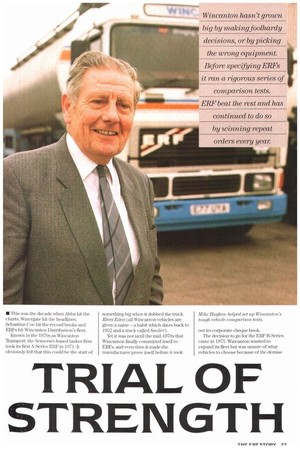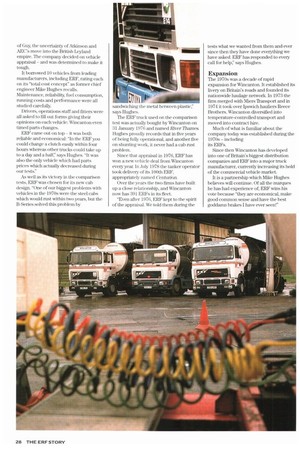TRIAL OF STRENGTH
Page 183

Page 184

If you've noticed an error in this article please click here to report it so we can fix it.
• This was the decade when Abba hit the charts, Watergate hit the headlit les, Sebastian Coe hit the record books and ERFs hit Wincanton Distribution's fleet,
Known in the 1970s as Wincanton '11-imsport, the Somerset-based tanker firm took its first A-Series EliF in 1971.11 obviously felt that this could be the start of something big when it dubbed the truck River Eden (all Wincanton vehicles are given a name a habit which dates back to 1932 and a truck called Smiler).
Yet it was not until the mid-1970s that Wincanton finally committed itself to ERFs, and even then it made the manufacturer prove itself before it took nut its corporate cheque book.
The decision to go for the ERF B-Series came in 1975. Wincanton wanted to expand its fleet but was unsure of what vehicles to choose because of the demise
of Guy, the uncertainty of Atkinson and AEC's move into the British Leyland empire. The compaily 4leeided on vehicle appraisal and was determined to make it tough.
It borrowed 10 vehicles from leading manufacturers, including ERF, rating each on its "total cast concept" as former chief engineer Mike Hughes recalls. Maintenance, reliability, fuel consumption, running costs and performance were all studied carefully.
Drivers, operations staff and fitters were all asked to fill out forms giving their opinions on each vehicle: Wincanton even timed parts changes.
ERE.' came out on top it was both reliable and economical: "In the ERF you could change a clutch easily within four hours whereas other trucks could take up to a day and a half," says Ilughes. "It. was also the only vehicle which had parts prices which actually decreased during our tests!'
As well as its victory in the comparison tests, ERF was chosen for its new cab design. "One of our biggest problems with vehicles in the 1071/s were the steel cabs which would rust within two years, but the B-Series solved this problem by sandwiching the metal between plastic," says Hughes.
The ERF truck used on the comparison test. was actually bought by Wincanton on 31 January 1976 and named River Thames Hughes proudly records that in five years of being fully operational, and another five on shunting work, it never had a cab rust problem.
Since that appraisal in 1976, ERF has won a new vehicle deal from Wincanton every year. In .July 1978 the tanker operator Look delivery of its 100th ERF, appropriately named Centurion,
Over the years the two firms have built up a close relationship, and Wincanton now has 391 ERFs in its fleet.
"Even after 1976. ERF kept to the spirit of the appraisal. We told them during the
tests what we wanted from them and ever since then they have done everything we have asked. ERF has responded to every call for help," says Hughes.
Expansion
The 1970s was a decade of rapid expansion for Wincanton. It established its livery on Britain's roads and founded its nationwide haulage network. In 1973 the firm merged with Miers "fransport and in 1974 it took over Ipswich hauliers Reece Brothers. Wincanton diversified into temperature-controlled transport and moved into contract hire.
Much of what is familiar about the company today was established during the 1970s including its ERFs.
Since then Wincanton has developed into one of Britain's biggest distribution companies and ERF into a major truck manufacturer, currently increasing its hold of the commercial vehicle market.
It is a partnership which Mike Hughes believes will continue. Of all the marques he has had experience of, ERF wins his vote because "they are economical, make good collation sense and have the best goddamn brakes I have ever seen!"




































































































































































































